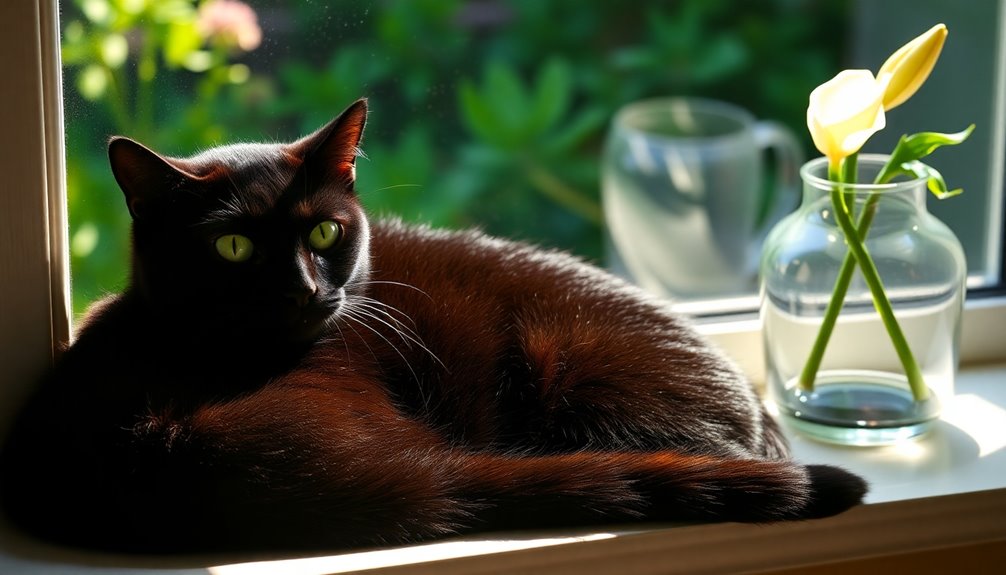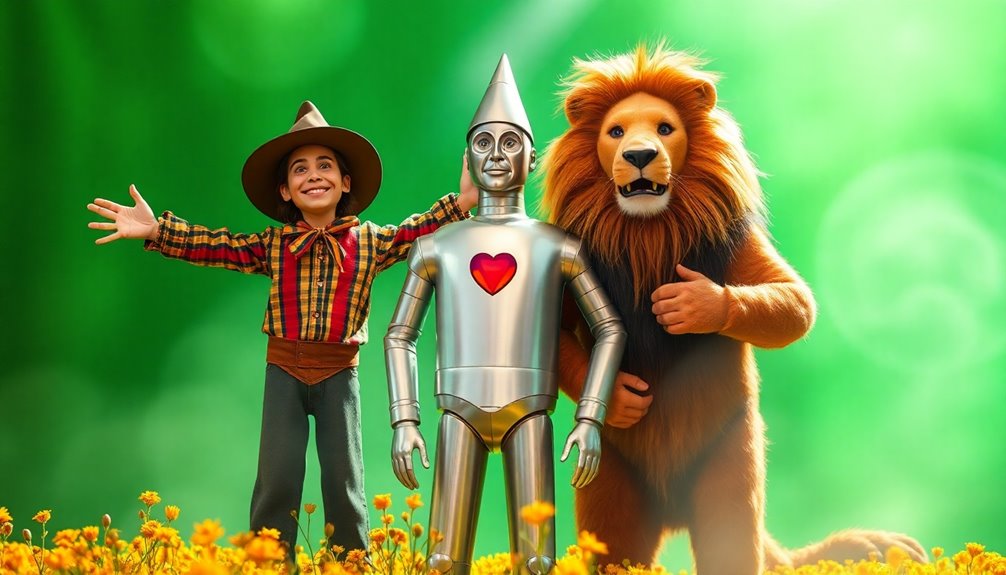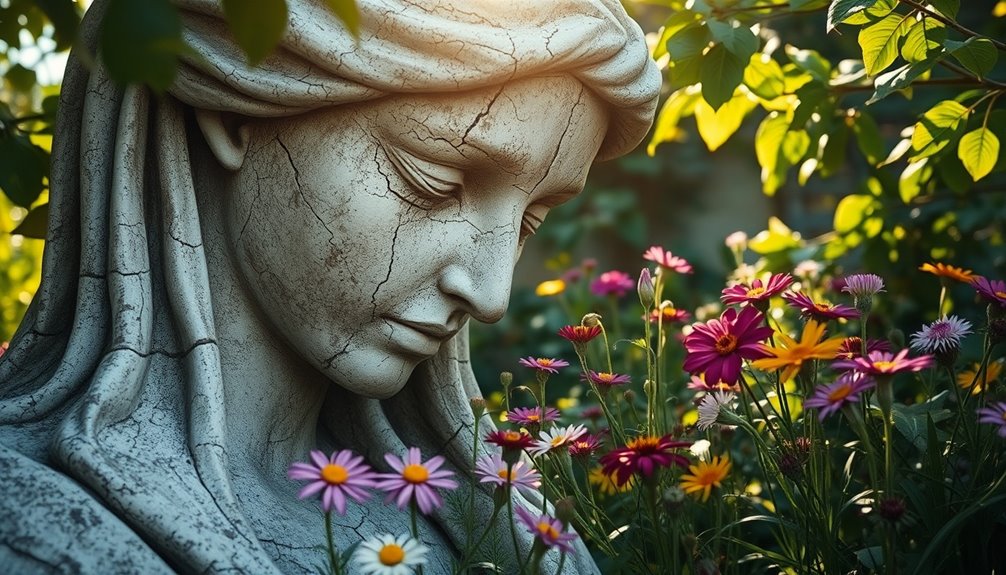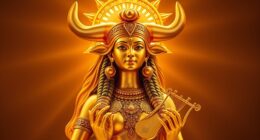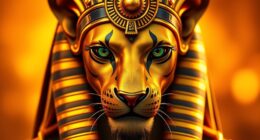Peacocks are incredible symbols of beauty, transformation, and spiritual awakening. Across cultures, they represent joy and elegance. For instance, in India, they bring happiness, while in China, they symbolize good luck. Mythologically, peacocks are linked to gods like Hera in Greek stories and represent protection and vigilance. Their vibrant feathers signify renewal and personal growth, reminding you to embrace change. Peacocks also appear in art, showcasing their regal nature. When you see one, it's a sign of self-love and acceptance. There's so much more to discover about these majestic birds and what they symbolize!
Key Takeaways
- Peacocks symbolize beauty and grace, representing nobility across various cultures and often associated with royalty and divinity.
- In mythology, they are linked to transformation and protection, notably with Hera in Greek mythology and Argus' story.
- Peacocks embody themes of personal growth and renewal, with their molting process representing acceptance and the cycle of life.
- They serve as guardians against negative energy, encouraging self-love, acceptance, and the embrace of one's unique qualities.
- In dreams, peacocks signify new beginnings and personal transformation, urging individuals to express their true selves and explore their inner worth.
Historical Significance of Peacocks
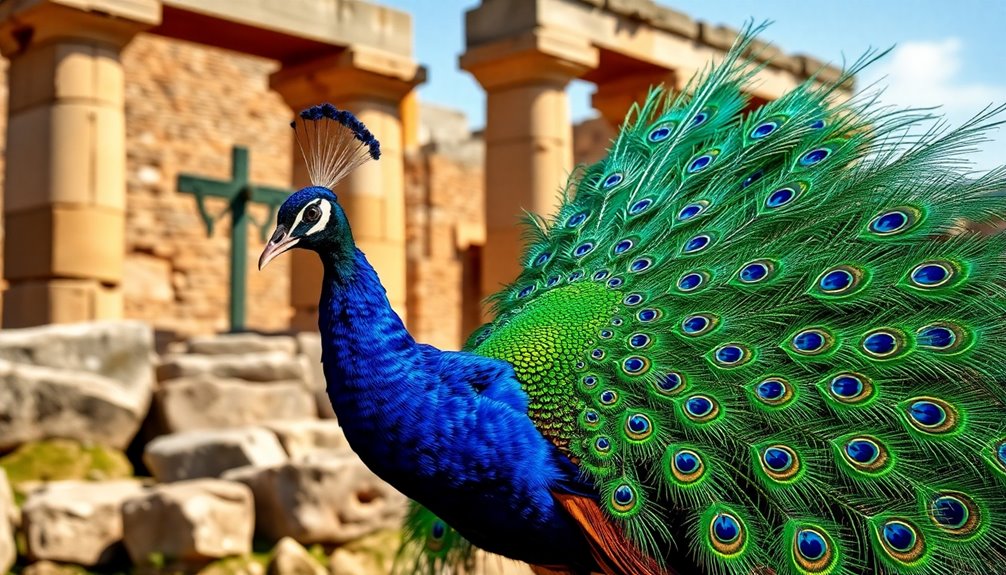
Throughout history, peacocks have served as powerful symbols of royalty and divinity across various cultures. You might be amazed to learn that these beautiful birds originated from the Indian subcontinent. Their stunning feathers and impressive displays made them a favorite among kings and queens.
One famous example is the Peacock Throne, created for Mughal Emperor Şah Jahan in the 17th century. It was adorned with sculpted peacocks and precious jewels, showcasing opulence and majesty.
Peacocks also hold a special place in Greek mythology. They're sacred to the goddess Hera, representing beauty and divine power. In her stories, peacocks are linked to the hundred-eyed giant Argus, making them even more enchanting.
Various ancient cultures, from the Egyptians to the Hindus, revered peacocks. They associated these magnificent birds with divinity, immortality, and good fortune.
You can find peacocks depicted in royal and religious art, highlighting themes of beauty, protection, and spiritual significance.
This historical significance of peacocks shows how they've been celebrated for their elegance and power throughout time, making them truly remarkable symbols in our world!
Mythological Associations
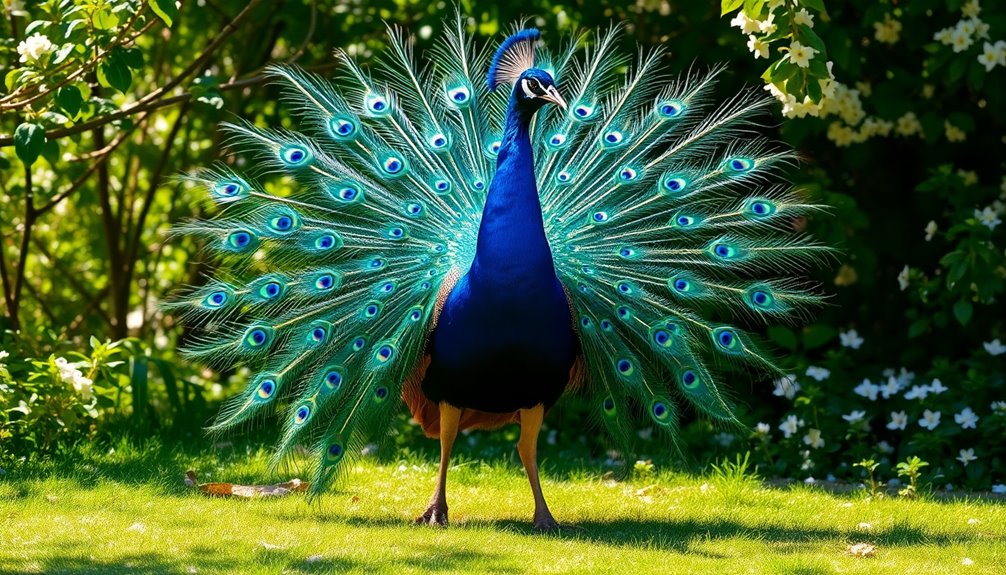
When you think about peacocks, it's exciting to explore their mythological connections!
In Greek mythology, they symbolize beauty and power, especially as a favorite of Hera, the queen of the gods.
Plus, they represent transformation and protection in cultures like Hinduism and Buddhism, making them truly special creatures across different stories.
Greek Mythology Connections
In Greek mythology, the peacock stands as a powerful symbol, closely associated with Hera, the queen of the gods. This beautiful bird is a sacred bird to Hera, representing her beauty and pride.
You might find it fascinating that the peacock's connection to Hera is highlighted in the myth of Argus. Argus was a giant with a hundred eyes, and after his death, he was transformed into a peacock as a tribute to Hera.
Peacocks were believed to pull Hera's chariot, adding to their majestic aura. This reinforces their strong link to divine power.
The symbolism of the peacock also explores themes of jealousy and protection, which reflect Hera's complex nature. She was known for her fierce protectiveness, especially when it came to her marriage to Zeus.
The peacock's vibrant plumage represents both beauty and vigilance. This duality echoes the qualities you might associate with Hera in her stories.
Symbols of Power
The peacock's striking appearance and rich symbolism make it a potent emblem of power across various mythologies. In Greek mythology, peacocks are sacred to Hera, representing beauty, pride, and divine authority. Imagine a majestic peacock pulling her chariot, serving as a reminder of her strength! In Hinduism, peacocks are linked to Lord Krishna, showcasing divine beauty through their colorful feathers.
Check out this table for more fascinating peacock symbolism:
| Culture | Symbolism of the Peacock | Key Traits |
|---|---|---|
| Greek Mythology | Beauty and divine power | Pride and vigilance |
| Hinduism | Renewal and spiritual growth | Vibrant plumage |
| Royalty | Nobility and grace | Regal appearance |
The peacock's eye-like feather patterns symbolize omnipotence and immortality, too. This reflects the ancient belief in their non-decaying flesh. Across cultures, peacocks are often seen as symbols of royalty, grace, and power. They inspire a sense of awe and admiration. So, when you think of peacocks, remember their deep connections to beauty and the spiritual growth they represent!
Transformation and Protection
Peacocks embody not just beauty and power but also themes of transformation and protection in various mythologies. In Greek tales, the peacock is sacred to Hera, showcasing her strength and protective nature. The vibrant colors of the peacock symbolize beauty and pride, but they also carry deeper meanings.
When Hera transformed Argus, a giant with a hundred eyes, into a peacock, it linked the bird to watchfulness and protection. Those many eyes remind you to be vigilant and aware.
In Buddhism, peacocks represent renewal and regeneration. They embody the protective qualities of spiritual growth and transformation. When a peacock sheds its old feathers for new ones, it symbolizes the cycle of life, showing how change can be beautiful. This process reminds you that transformation is a part of growing up.
Throughout different cultures, peacocks are seen as guardians. Their majestic presence wards off negative energy, creating a sense of safety.
Cultural Symbolism
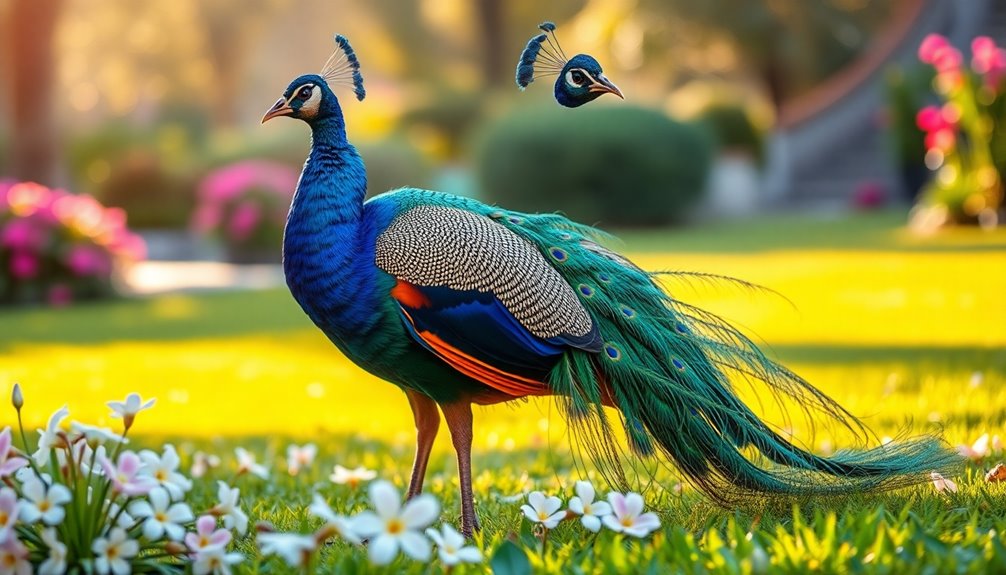
Peacocks are celebrated in many cultures around the world, and their symbolism is pretty amazing!
In India, they represent beauty and joy, while in China, they bring good luck and prosperity.
Each culture has its own special connection to peacocks, showing just how important these colorful birds are in our stories and traditions.
Global Cultural Significance
Throughout history, various cultures have embraced the peacock as a powerful symbol, weaving its imagery into their traditions and beliefs. In China, the peacock represents peace, prosperity, and happiness. People use its symbolism in feng shui to attract good fortune into their lives. Imagine having such beauty surrounding you!
In Hinduism, the peacock is sacred and linked to Lord Krishna. It brings good luck and joy, especially during lively festivals.
Greek mythology connects peacocks to Hera, the queen of the gods. Here, the peacock symbolizes beauty, pride, and jealousy, making it a fascinating creature in stories.
Buddhism sees peacocks as symbols of renewal and openness. Their vibrant feathers and molting process represent acceptance and immortality. It's a reminder that change can be beautiful!
Across different civilizations, peacocks have been admired as symbols of nobility and royalty. You might find them in royal insignias or heraldry, showcasing power and beauty.
With such rich cultural significance, the peacock truly captivates the imagination, making it a delightful symbol to explore!
Mythological Associations Across Cultures
Exploring the mythological associations of peacocks reveals a rich tapestry of cultural symbolism that spans various civilizations. These vibrant birds have captured the imagination of many, and their flamboyant display often symbolizes different virtues and beliefs.
In Greek mythology, the peacock is sacred to Hera, representing beauty and pride. The eyes on its feathers are said to belong to her guardian, Argus. Similarly, in Hinduism, the peacock is associated with Lord Krishna, signifying good luck and divinity, especially during joyous festivals.
In Buddhism, peacocks represent renewal and regrowth, showcasing qualities of acceptance and immortality. Ancient Egyptians connected peacocks with the All-Seeing Eye of Horus, symbolizing protection and divine vision.
Lastly, in Chinese culture, peacocks embody peace, prosperity, and happiness, often used in feng shui practices to attract good energy.
| Culture | Symbolism |
|---|---|
| Greek | Beauty and pride |
| Hindu | Good fortune and divinity |
| Buddhism | Renewal and immortality |
| Ancient Egypt | Protection and divine vision |
| Chinese | Peace and prosperity |
Peacocks truly are remarkable symbols across cultures!
Artistic Representation

The vibrant plumage of the peacock has captured the imagination of artists across cultures and centuries. When you look at peacocks in art, you see that they symbolize beauty, power, and even the divine! Their stunning feathers often appear in royal and religious artworks, showcasing rich symbolism that speaks to many people.
Take Shen Quan's 1742 ink-on-silk illustration, for example; it beautifully captures the grandeur of these magnificent birds. Edward Burne-Jones, a famous artist from the Pre-Raphaelite movement, created a piece titled "A Peacock," highlighting the bird's cultural significance and aesthetic appeal.
In many artistic portrayals, you'll notice gold detailing and intricate designs, especially in Byzantine-inspired works, emphasizing the peacock's regal nature.
Even today, artists continue to find inspiration in peacocks! Modern works, like Raymond Lister's "The Peacock and the Cloud," blend fantasy and nature, showing that these birds still hold a special place in contemporary creativity.
Whether in paintings, sculptures, or illustrations, peacocks remain a joyful symbol of beauty and elegance, continuing to inspire artists worldwide!
Spiritual Symbolism
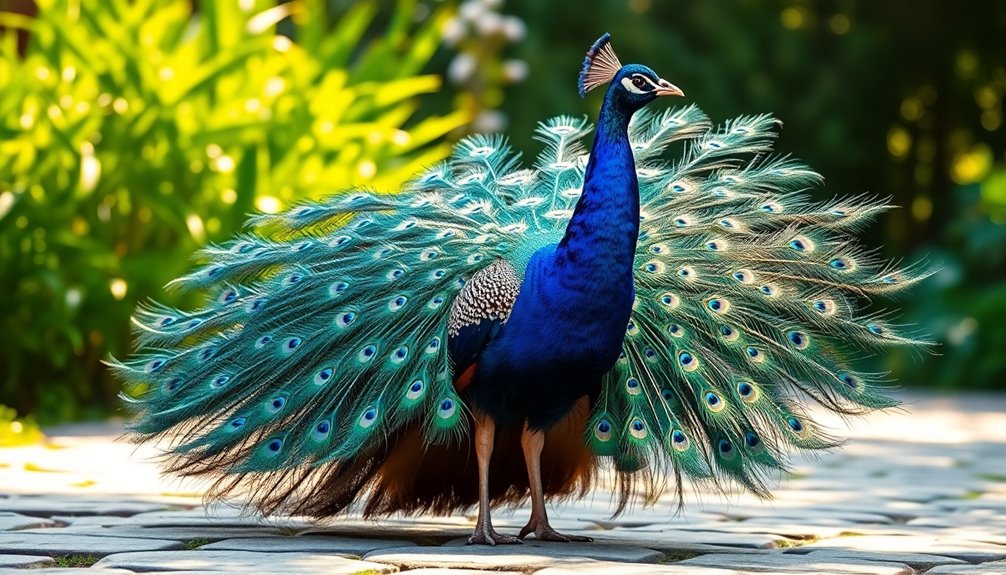
Peacocks hold profound spiritual symbolism that resonates across various cultures. When you think of a peacock, imagine it as a messenger of spiritual awakening and enlightenment. The vibrant colors and striking beauty of the peacock symbolize a higher state of consciousness. It helps you see beyond the physical world, inviting you to explore your spiritual side.
One fascinating aspect is how the peacock represents transformation. Just like the peacock molts its feathers, you too can experience personal growth and renewal. This encourages you to embrace change on your spiritual journey. When you see a peacock, think of it as a reminder that transformation is a natural part of life.
In many cultures, peacocks are linked to beauty and individuality. They celebrate your unique traits, urging you to express yourself freely. If you dream of a peacock, consider it a sign of positive renewal. It indicates a potential for spiritual growth and encourages you to explore your spiritual path.
Modern Interpretations
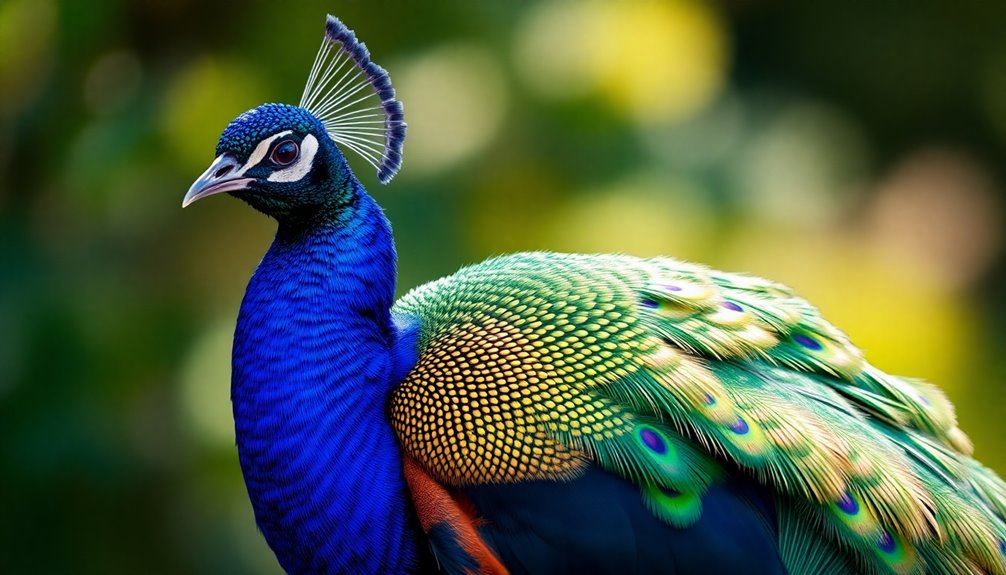
Symbolism continues to evolve, and modern interpretations of peacocks reflect this dynamic change. Today, the peacock tail, with its vibrant and colorful feathers, represents beauty and elegance in many art forms. Artists like Raymond Lister have taken these magnificent birds and reimagined them in abstract styles. They explore themes of nature and fantasy, making peacocks shine in modern artistic contexts.
You might notice peacocks popping up in fashion and branding, too! They symbolize luxury and opulence, capturing the world's ongoing fascination with their historical significance. When you see a peacock design, it often evokes a sense of confidence and self-expression. That's because, in popular media, the peacock embodies the celebration of individuality.
Contemporary artworks, like "Orientation Panel; Peacock," use jewel-like colors to bring the peacock's natural vibrancy to life. These pieces engage with modern trends while keeping the spirit of the peacock alive.
Symbolism in Dreams
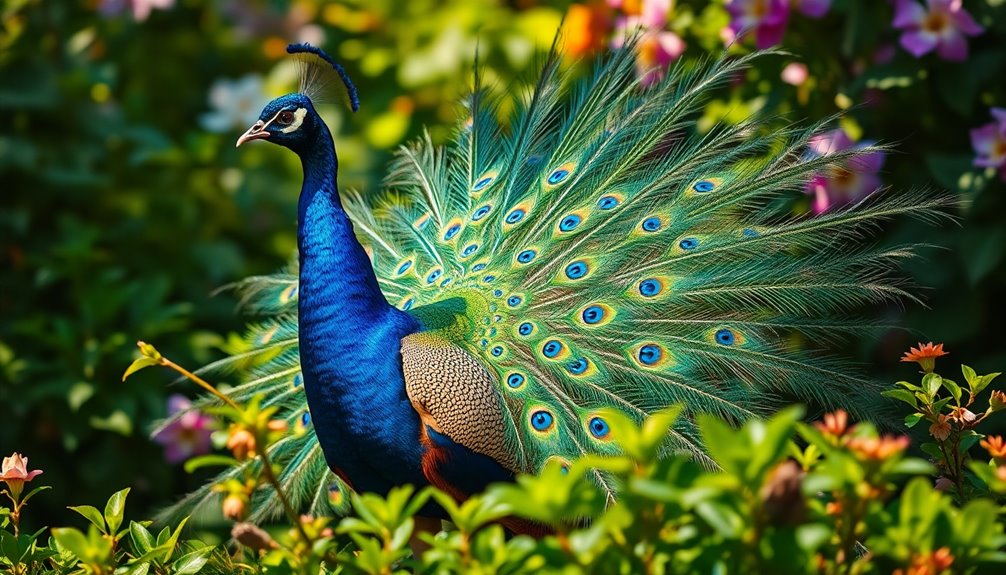
Dreams featuring peacocks often serve as powerful symbols of personal transformation and renewal. When you dream of these magnificent birds, it can mean you're entering a time of new beginnings. The beauty of their peacock tail reminds you to embrace your unique qualities and explore your spiritual side.
Here are some key ideas to think about when interpreting your peacock dreams:
- Personal Growth: You might be experiencing significant changes in your life.
- Communication from the Universe: These dreams may be messages urging you to express your true self.
- Warning Against Superficiality: Be mindful not to get caught up in appearances; remember your inner worth.
- Messages from Loved Ones: Sometimes, peacocks in dreams remind you of loved ones watching over you.
When you see a peacock in your dream, reflect on your feelings and circumstances. It's an exciting opportunity to learn about yourself and your journey.
Embrace the symbolism and let it inspire you to grow and shine brightly in your life!
Common Peacock Sightings

In various cultures, frequent sightings of these stunning birds are often seen as good omens, signaling self-love and acceptance in your life. When you spot a peacock, it's like nature is giving you a special message!
The peacock tail, with its vibrant colors and mesmerizing patterns, reminds you to embrace your individuality.
Seeing these gorgeous creatures can hint at positive changes coming your way. It's a gentle nudge to appreciate the beauty in yourself and your surroundings. Maybe you're on the brink of new opportunities, and the peacock's presence encourages you to take that leap.
Additionally, peacock sightings may serve as a form of protection. Many believe that these magnificent birds ward off negativity, filling your space with positive energy.
When you encounter a peacock, think of it as a sign to be confident and proud of who you are.
Practical Meanings and Insights
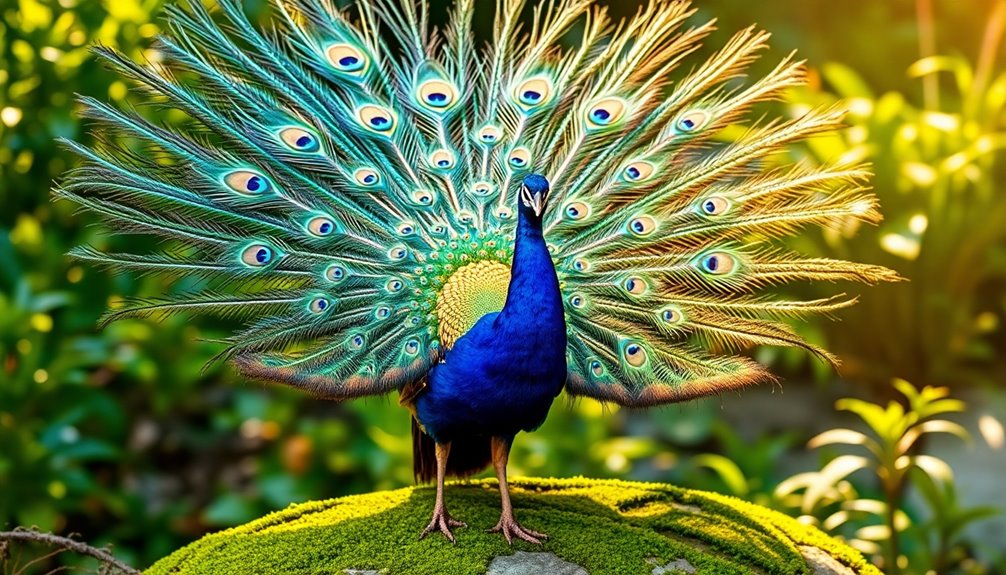
Spotting a peacock can spark curiosity about what their presence means in your life. These stunning birds, with their iridescent tail feathers and mesmerizing peacock feathers, carry deep meanings. When you see one, consider the following insights:
- Beauty and Confidence: Peacocks remind you to embrace your unique qualities and express yourself fully.
- Protection and Security: Their protective nature symbolizes safety, encouraging you to create a secure space for yourself and loved ones.
- Spiritual Awakening: Peacocks are often seen as messengers of spiritual growth, inviting you to explore your inner self.
- Positive Changes: Frequent sightings can indicate that good things are on the way, urging you to be open to new opportunities.
Next time you encounter a peacock, let its vibrant energy inspire you. Think about how you can incorporate its lessons into your life.
Whether it's embracing your beauty, finding security, or welcoming positive changes, a peacock's presence can be a joyful reminder to celebrate who you're and the journey you're on!
Frequently Asked Questions
What Is the Spiritual Meaning of the Peacock?
The spiritual meaning of the peacock is all about growth and transformation.
When you see a peacock, it reminds you to embrace your unique qualities and express your true self. It encourages you to explore your spiritual journey, helping you see beyond the everyday world.
Spotting a peacock can be a sign of good fortune and positive changes ahead, so pay attention! You're on a path to becoming your best self.
What Does the Peacock Symbolize in the Bible?
In the Bible, the peacock symbolizes beauty and pride, showcasing the splendor of God's creation.
You'll notice its connection to wealth, especially in the luxurious Temple of Solomon.
The peacock also represents renewal because it can shed and regrow its feathers, reflecting ideas of resurrection.
This ties to Christian beliefs about eternal life, as the peacock's flesh was thought not to decay, offering hope in the promise of everlasting life through Christ.
What God Has a Peacock Symbol?
Have you ever seen a peacock strutting its stuff?
In many cultures, different gods have this beautiful bird as a symbol. For instance, in Hinduism, you'll find the peacock linked to Lord Krishna, showcasing love and devotion.
In Greek mythology, it represents Hera, the queen of the gods, symbolizing her beauty and pride.
Each tale brings the peacock to life, reminding us of its special connection to the divine across various traditions!
What Does the Female Peacock Symbolize?
The female peacock, or peahen, symbolizes nurturing and motherhood. She's all about protecting her young and ensuring they thrive.
Unlike the flashy male, her subtle colors help her blend into the environment, keeping her and her chicks safe. Peahens also represent fertility and abundance, showing their importance in nature.
When choosing a mate, they value inner qualities over looks, highlighting the beauty of discernment and the strength found in modesty.
Isn't that amazing?
Conclusion
To sum up, peacocks are more than just beautiful birds; they're like walking rainbows, full of meaning! Through history, mythology, and art, they've captured our imaginations. Whether you see them in your dreams or in the wild, peacocks remind us of beauty, pride, and transformation. So next time you spot one, take a moment to appreciate all the colors and stories they bring. Embrace the joy and wonder they symbolize in our lives!





